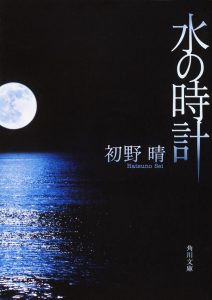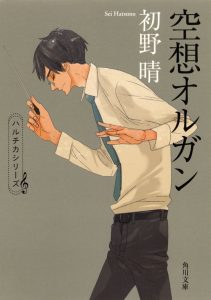
The second part of the dialogue between HaruChika author Hatsuno Sei and book reviewer Ooya Hiroko on the fantasy elements in HaruChika and his other works. Translated from the article at honto.jp on March 30, 2016.
HaruChika has one leg in fantasy, doesn’t it?
Ooya: Hatsuno-san. In 2002 you debuted with “Mizu no Tokei”(Water Clock), which was modeled after Oscar Wilde’s fairy tale “The Happy Prince”, and won the 22nd Yokomizo Seishi Mystery Prize. After that you wrote dark fantasy mysteries for a while. For that reason the comedic youth orthodox mystery in “HaruChika” in 2008 surprised me. It was completely different from what you had written until then.

Hatsuno: Continuing to write dark fantasy happened to be by chance. Before I debuted, I wrote experimental novels, short stories, and the like. Nearly all of them were comedic. For example, I wrote a stupid story about a serial murder incident by means of a mountain bicycle. It occurs in front of a train station, and a suspicious detective takes a word processor from his bag and says, “Look! The mountain bike converts to a demon-operated bike with my word processor!” (lol).
Ooya: Ah, just now I earnestly thought how great it is that “Mizu no Tokei” won the Yokomizo prize… Even now, you’re writing dark fantasy with the exception of “HaruChika”, right?
Hatsuno: Because I long for universal stories. That’s why I avoid writing place names and proper nouns wherever possible. I find it absurd to even call it borrowing the power of a fairy-tale, but I modeled it in some facets after one.
Ooya: Because HaruChika completely differs from the fantasy-style works you’ve written…
Haruta’s Position as a God or Angel Within the Story
Hatsuno: HaruChika has one leg in fantasy too, though. I love Kindaichi Kousuke[ref]A famous fictional Japanese detective created by Yokomizo Seishi[/ref]. He descends onto the stage, solves a mystery, and leaves. Haruta might be closely modeled after Kindaichi Kousuke. He’s almighty when it comes to solving mysteries, but Haruta is unable to solve the fundamental problem. I wanted to depict that it is up to the enthusiasm of ordinary high schoolers like Homura Chika and the others to deal with that aftermath.
Ooya: Ah, Haruta certainly isn’t able to solve problems! To begin with, the cases they’re handling are often in the hands of high schoolers. That’s why an adult appears at the end and Chika-chan stirs up everyone’s mood.
Hatsuno: Then there’s Haruta’s creation. In the novel he never uses direct words to say that he likes or loves Kusakabe-sensei, and I don’t have the plan on writing it after this either. But I allowed him to possess an “ambiguity” of sexuality, or perhaps I should say, “faintness”. I am also keeping his position of the god or angel within the detective story in mind. There’s a fantasy-like image, and this is why he will not fall in love with Homura Chika.
Ooya: Ah, so it was like that!
Hatsuno: HaruChika does not depict realistic high schoolers to begin with. It’s a strange assumption that if you don’t depict boys and girls realistically, it’s not telling the present day. There are plenty of excellent documentary books concerning wind ensemble clubs, such as Ishikawa Takako-san’s Buraban Kids Series. Using those as data material, anyone can write wind ensemble club fiction without fearing to be at fault. On top of looking over documentary books as much as I can, I write in a direction which avoids the heroism route as one can see in sports stories.
Ooya: There’s certainly zero heroism which can be usually found in club stories…
Life Continues After Graduation
Hatsuno: I’m poor at it. Because the creator as well as the listener cannot imagine not being able to move one’s dominant arm suddenly one day. While writing “HaruChika”, I listened to a speech of a female alumni from a famous school who once stood on the stage of the Fumon Hall. If I restrict myself to what she talked about, she didn’t touch her instrument after she graduated from high school even once. She endured a rigid practice that would put those in sports to shame. No matter how long she burned, she would quit once she graduated from high school. Even if she wanted to become a musical professional, there’s a different route called a college of music. A college of music doesn’t have a link with high school wind instrument clubs. So, for what purpose is she doing wind instrument music?

If I had a theme, it would be that one. HaruChika isn’t confined to the closed, narrow world which we call club activities. While placing it next to the constant music, they go off-campus, encounter an adult they usually don’t interact with, and touch upon history as well. Throughout the books I am repeatedly expressing the fact that life continues as well after graduation from high school.
Ooya: Aah, that! I talked about fantasy, but I think that’s the realistic part instead. You resort to adults about the things you don’t know, and adults teach you about those things.
Hatsuno: If you stumble, you can stretch yourself from the closed world once: to solve something it’s better to look beyond the people in your surroundings. I think that doing the hard club activities of the high school wind ensemble club, while having various personal experiences and expanding one’s vision is the best way of writing HaruChika.
Leave a Reply